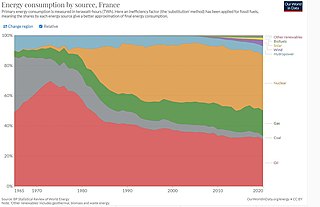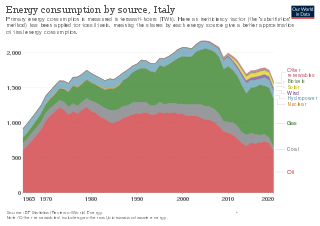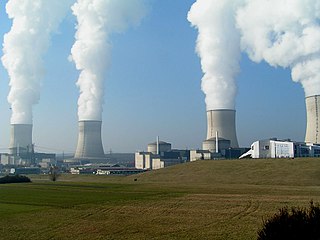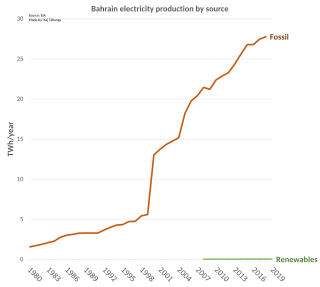
Venezuela was one of the world's largest producers of oil, and the country with the largest proven oil reserves in the world. Venezuela is a member of OPEC.
Contents
Electricity in Venezuela is predominantly produced from hydroelectricity.

Venezuela was one of the world's largest producers of oil, and the country with the largest proven oil reserves in the world. Venezuela is a member of OPEC.
Electricity in Venezuela is predominantly produced from hydroelectricity.
| Capita | Prim. energy | Production | Export | Electricity | CO2-emission | |
|---|---|---|---|---|---|---|
| Million | TWh | TWh | TWh | TWh | Mt | |
| 2004 | 26.1 | 653 | 2,280 | 1,623 | 72.1 | 128 |
| 2007 | 27.5 | 741 | 2,138 | 1,381 | 84.6 | 144 |
| 2008 | 27.9 | 745 | 2,102 | 1,340 | 85.9 | 146 |
| 2009 | 28.4 | 778 | 2,367 | 1,503 | 89.5 | 155 |
| 2010 | 28.83 | 895 | 2,241 | 1,353 | 94.77 | 183.04 |
| 2012 | 29.28 | 816 | 2,335 | 1,506 | 97.73 | 159.22 |
| 2012R | 29.96 | 888 | 2,318 | 1,405 | 101.88 | 178.28 |
| 2013 | 30.41 | 800 | 2,235 | 1,405 | 98.25 | 155.57 |
| Change 2004-10 | 10.3% | 37.0% | -1,7% | -16,6% | 31.4% | 42.6% |
| Mtoe = 11.63 TWh, Prim. energy includes energy losses 2012R = CO2 calculation criteria changed, numbers updated | ||||||
Venezuela ranked 11th in the world for oil production in 2016; production has since fallen steeply. [2]
The largest oil company is Petróleos de Venezuela (PDVSA).
Oil fields in the country include Bolivar Coastal Field, Boscán Field, Maracaibo Basin and Orinoco Belt.

Hydro power provided 74% of domestic electricity in 2008. Venezuela produced 87 TWh hydro power in 2008, 2.6% of the world total. Venezuela was top 8th in hydro electricity in 2008. [3]
| Wikimedia Commons has media related to Energy in Venezuela . |

According to the International Energy Agency, France has historically generated a very low level of carbon dioxide emissions compared to other G7 economies due to its reliance on nuclear energy. Energy in France is generated from five primary sources: coal, natural gas, liquid fuels, nuclear power, and renewables. In 2020, nuclear power made up the largest portion of electricity generation, at around 78%. Renewables accounted for 19.1% of energy consumption. France has the largest share of nuclear electricity in the world. The country is also among the world's biggest net exporters of electricity. The country is increasingly investing in renewable energy and has set a target of 32% by 2030.

Ensuring adequate energy supply to sustain economic growth has been a core concern of the Chinese government since 1949. The country is the world's largest emitter of greenhouse gases, and coal in China is a major cause of global warming. However, from 2010 to 2015 China reduced energy consumption per unit of GDP by 18%, and CO2 emissions per unit of GDP by 20%. On a per-capita basis, it was the world's 51st largest emitter of greenhouse gases in 2016.
Energy in Kazakhstan describes energy and electricity production, consumption and import in Kazakhstan. Energy policy of Kazakhstan describes the politics of Kazakhstan related to energy.

Energy in Mexico describes energy and electricity production, consumption and import in Mexico.

Energy in Romania describes energy and electricity production, consumption and import in Romania.

South Korea is a major energy importer, importing nearly all of its oil needs and ranking as the second-largest importer of liquefied natural gas in the world. Electricity generation in the country mainly comes from conventional thermal power, which accounts for more than two thirds of production, and from nuclear power.

Italy consumed about 185 Mtoe of primary energy in 2010. This came mostly from fossil fuels. Among the most used resources are petroleum, natural gas, coal and renewables.

The electricity sector in France is dominated by its nuclear power, which accounted for 71.7% of total production in 2018, while renewables and fossil fuels accounted for 21.3% and 7.1%, respectively. France has the largest share of nuclear electricity in the world, and together with renewable energy supplies, this has helped its grid achieve very low carbon intensity.

Energy in Singapore describes energy related issues in Singapore, which is a developed country located in eastern Asia. Energy exports to others are about three times the primary energy supplied in the country itself. Additionally, oil imports in relation to the population demands of the country itself are concerningly high.

South Africa has a large energy sector, being the third-largest economy in Africa. The country consumed 227 TWh of electricity in 2018. The vast majority of South Africa's electricity was produced from coal, with the fuel responsible for 88% of production in 2017. South Africa is the 7th largest coal producer in the world. As of July 2018, South Africa had a coal power generation capacity of 39 gigawatts (GW). South Africa is the world's 14th largest emitter of greenhouse gases. South Africa is planning to shift away from coal in the electricity sector. The country aims to decommission 34 GW of coal-fired power capacity by 2050. It also aims to build at least 20 GW of renewable power generation capacity by 2030.

Energy in Kuwait describes energy and electricity production, consumption, import and export in Kuwait. Energy policy of Kuwait will describe the politics of Kuwait related to energy more in detail. Electricity sector in Kuwait is the main article of electricity in Kuwait.

Energy in Algeria describes energy and electricity production, consumption and import in Algeria. Energy policy of Algeria will describe the energy policy in the politics of Algeria more in detail. Algeria is an OPEC country.

Energy in Iraq is mostly oil and gas.

Energy in the Netherlands describes energy and electricity production, consumption and import in the Netherlands. Electricity sector in the Netherlands is the main article of electricity in the Netherlands.
Energy in the United Arab Emirates describes energy and electricity production, consumption and import in the United Arab Emirates (UAE). UAE has 7% of global proved oil reserves, about 100 billion barrels. Primary energy use in 2009 in UAE was 693 TWh and 151 TWh per million persons.
Energy in the Czech Republic describes energy and electricity production, consumption and import in the Czech Republic.
Energy in Estonia depends on fossil fuels. The Estonian energy company Eesti Energia owns the largest oil shale-fuelled power plants in the world, Narva Power Plants.

Energy in Bahrain describes energy and electricity production, consumption and import in Bahrain. Baharain is net energy exporter.

Energy in Yemen describes energy and electricity production, consumption and import in Yemen. Yemen is net energy exporter.

Energy in Belarus describes energy and electricity production, consumption and import in Belarus. Belarus is a net energy importer. According to IEA, the energy import vastly exceeded the energy production in 2015, describing Belarus as one of the world's least energy sufficient countries in the world. Belarus is very dependent on Russia.